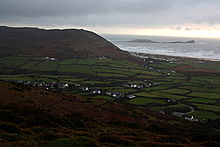|
|
|
|
Worm's HeadEnclosure
|
||||||||||||||||||||||||
|
|
|
Images (click to view fullsize) |
|
Photographs:













 Artistic / Interpretive:
Artistic / Interpretive:
|
Fieldnotes |
|
| When I visited Worm's Head earlier this year it was a bright but cold and very windy day. I viewed the surrounding coastline (with binoculars) and could see no obvious 'lumps and bumps'. There is a pay-and-display car park, cafe and N.T. shop. |
Posted by CARL 11th May 2010ce |
Folklore |
|
|
Baring-Gould says "There can hardly be a doubt that by Henisweryn the Worm's Head Island is intended" (he explains in detail why he thinks so) The story's of Saint Cenydd's a bit long (and this is only the start) - but as BG says, "It is a most extraordinary tale, a mass of fable. It was certainly composed after Geoffrey of Monmouth had made the fortunes of King Arthur, i.e. 1150. That it contains earlier matter is not to be doubted; not of an historical, but of a mythological character." In the days of King Arthur, the prince of Letavia (Llydaw) or Britannia Minor, was Dihoc, and he became the father of Keneth, who was born of incest. Summoned by King Arthur, as a tributary, to come to his court to celebrate the Feast of Christmas in Gower, he took with him the woman, and she gave birth to a child, who was born a cripple, with the calf of one leg attached to the thigh.It goes on a bit as you can imagine, and you can read the rest here in Baring-Gould's 'Lives of the British Saints' (1907). It's got such curious and celticky detail, with all those helpful animals. *Here there's some Latin which Google translate tells me means the child did not poo. Clearly too rude to write in English for a vicar. But incest and child murdering is ok. |
 Posted by Rhiannon
Posted by Rhiannon26th March 2012ce Edited 26th March 2012ce |
Camden, in his "Britannia," informs us, -- "In a rock in the island of Barry, in Glamorganshire, there is a narrow chink, or cleft, to which if you put your ear you shall perceive all such sorts of noises as you may fancy smiths at work under ground, strokes of hammers, blowing of bellows, grinding of tools." At Worm's head, in the peninsular of Gower in Glamorganshire, these sounds are, even now, often heard; and it requires but a moderate stretch of imagination to create all this cyclopean imagery, when the sea is rolling in cavities under our feet, and the tone of its voice is magnified by confinement and repercussion.From p151 of 'The Philosophy of Mystery' by Walter Cooper Dendy (1841). I've since found out it wasn't Camden at all - it was Giraldus Cambrensis: .. In a rock or cliff, by the sea=side in Glamorganshire, near the Isle of Barry, there appeareth a little chink, into which, if you lay your ear, you shall hear a noise as of smiths at work - one while the blowing of bellows, another while striking of sledge and hammer, sometime the sound of the grindstone and iron tools rubbing against it, the hissing sparks also of steel gads within holes as they are beaten, yea and the puffing noise of fire burning in the furnace. Now I am persuaded that the sound comes of the rush of the sea water. Sounds far too complicated for that. But you could be right. |
 Posted by Rhiannon
Posted by Rhiannon17th September 2007ce Edited 26th March 2012ce |
Miscellaneous |
|
|
30.9.13 I walked down past the Coastguard building and was afforded great views of Worm’s Head. Although I had seen Worm’s Head many times in the past it had always been from further away and now up (relatively) close I had a better appreciation of its size. It’s a lot bigger than it looks from further afield. The information board states that Worm’s head is accessible 2 hours either side of low tide. However, when I looked the causeway was till underwater so perhaps a ‘low’ low tide is required? Or perhaps today was a particularly ‘high’ low tide – if that makes sense? Either way, a view from the mainland was the closest I was going to get to it. |
Posted by CARL 2nd October 2013ce |
Links |
|
National Coastwatch47 people have been rescued from Worm's Head since the lookout station opened in March 2007. Don't say you weren't warned! |
 Posted by thesweetcheat
Posted by thesweetcheat20th April 2012ce |

